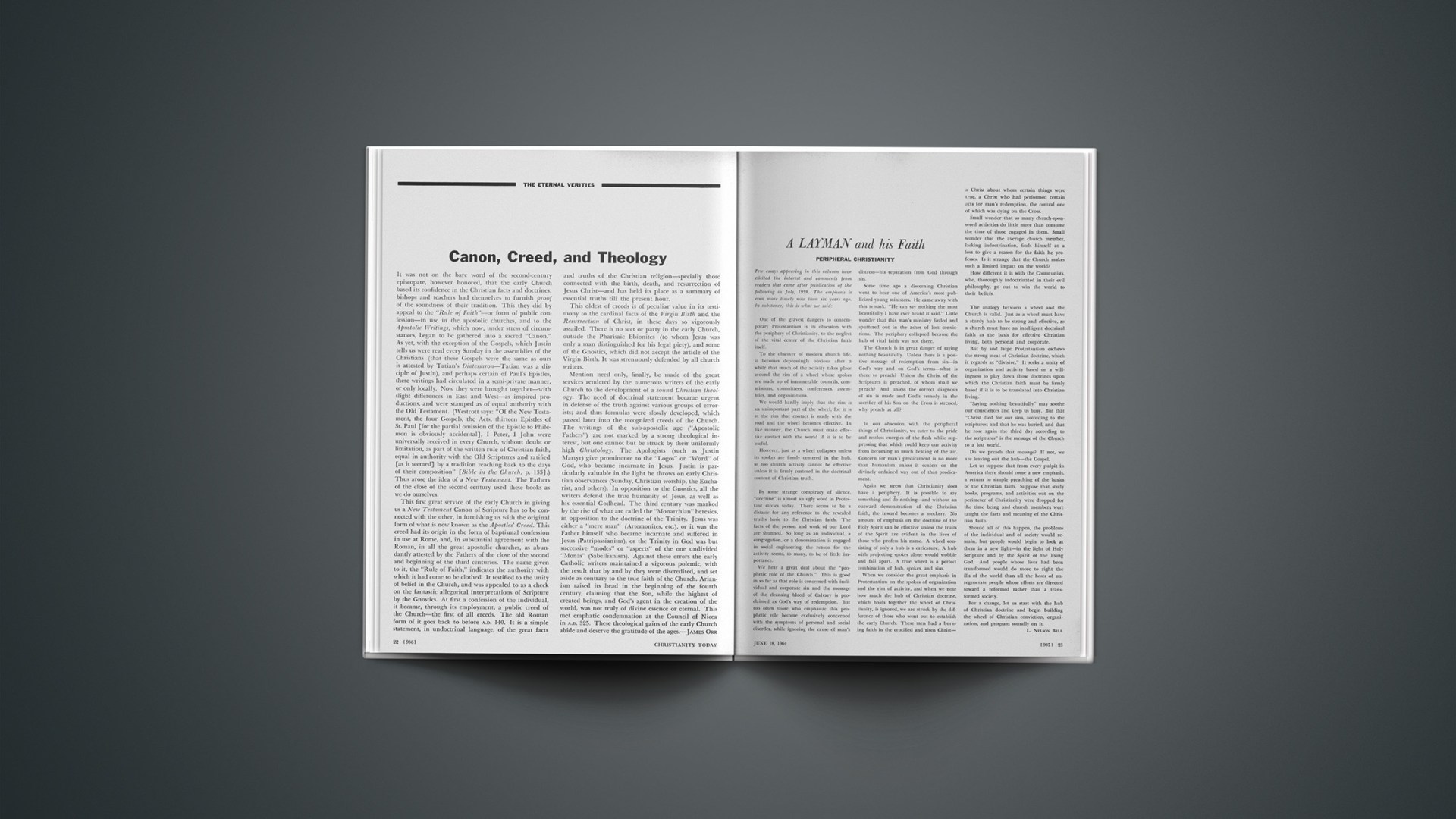It was not on the bare word of the second-century episcopate, however honored, that the early Church based its confidence in the Christian facts and doctrines; bishops and teachers had themselves to furnish proof of the soundness of their tradition. This they did by appeal to the “Rule of Faith”—or form of public confession—in use in the apostolic churches, and to the Apostolic Writings, which now, under stress of circumstances, began to be gathered into a sacred “Canon.” As yet, with the exception of the Gospels, which Justin tells us were read every Sunday in the assemblies of the Christians (that these Gospels were the same as ours is attested by Tatian’s Diatessaron—Tatian was a disciple of Justin), and perhaps certain of Paul’s Epistles, these writings had circulated in a semi-private manner, or only locally. Now they were brought together—with slight differences in East and West—as inspired productions, and were stamped as of equal authority with the Old Testament. (Westcott says: “Of the New Testament, the four Gospels, the Acts, thirteen Epistles of St. Paul [for the partial omission of the Epistle to Philemon is obviously accidental], I Peter, I John were universally received in every Church, without doubt or limitation, as part of the written rule of Christian faith, equal in authority with the Old Scriptures and ratified [as it seemed] by a tradition reaching back to the days of their composition” [Bible in the Church, p. 133].) Thus arose the idea of a New Testament. The Fathers of the close of the second century used these books as we do ourselves.
This first great service of the early Church in giving us a New Testament Canon of Scripture has to be connected with the other, in furnishing us with the original form of what is now known as the Apostles’ Creed. This creed had its origin in the form of baptismal confession in use at Rome, and, in substantial agreement with the Roman, in all the great apostolic churches, as abundantly attested by the Fathers of the close of the second and beginning of the third centuries. The name given to it, the “Rule of Faith,” indicates the authority with which it had come to be clothed. It testified to the unity of belief in the Church, and was appealed to as a check on the fantastic allegorical interpretations of Scripture by the Gnostics. At first a confession of the individual, it became, through its employment, a public creed of the Church—the first of all creeds. The old Roman form of it goes back to before A.D. 140. It is a simple statement, in undoctrinal language, of the great facts and truths of the Christian religion—specially those connected with the birth, death, and resurrection of Jesus Christ—and has held its place as a summary of essential truths till the present hour.
This oldest of creeds is of peculiar value in its testimony to the cardinal facts of the Virgin Birth and the Resurrection of Christ, in these days so vigorously assailed. There is no sect or party in the early Church, outside the Pharisaic Ebionites (to whom Jesus was only a man distinguished for his legal piety), and some of the Gnostics, which did not accept the article of the Virgin Birth. It was strenuously defended by all church writers.
Mention need only, finally, be made of the great services rendered by the numerous writers of the early Church to the development of a sound Christian theology. The need of doctrinal statement became urgent in defense of the truth against various groups of errorists; and thus formulas were slowly developed, which passed later into the recognized creeds of the Church. The writings of the sub-apostolic age (“Apostolic Fathers”) are not marked by a strong theological interest, but one cannot but be struck by their uniformly high Christology. The Apologists (such as Justin Martyr) give prominence to the “Logos” or “Word” of God, who became incarnate in Jesus. Justin is particularly valuable in the light he throws on early Christian observances (Sunday, Christian worship, the Eucharist, and others). In opposition to the Gnostics, all the writers defend the true humanity of Jesus, as well as his essential Godhead. The third century was marked by the rise of what are called the “Monarchian” heresies, in opposition to the doctrine of the Trinity. Jesus was either a “mere man” (Artemonites, etc.), or it was the Father himself who became incarnate and suffered in Jesus (Patripassianism), or the Trinity in God was but successive “modes” or “aspects” of the one undivided “Monas” (Sabellianism). Against these errors the early Catholic writers maintained a vigorous polemic, with the result that by and by they were discredited, and set aside as contrary to the true faith of the Church. Arianism raised its head in the beginning of the fourth century, claiming that the Son, while the highest of created beings, and God’s agent in the creation of the world, was not truly of divine essence or eternal. This met emphatic condemnation at the Council of Nicea in A.D. 325. These theological gains of the early Church abide and deserve the gratitude of the ages.—JAMES ORR










